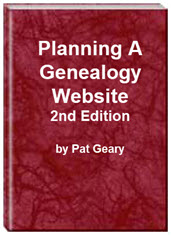- Home
- Resources
- Articles
- Tutorials
- Tutorials & Articles
- Add Search Box
- Converting a Theme Based Site to DWT
- Converting a Table Based Layout
- Create custom Error Pages
- Create 301 Redirects
- Creating a New Website
- Creating a FrontPage Web
- Create a Gradient Image
- Creating Layered Backgrounds
- Creating A Navigation Menu
- Creating Website Navigation
- Heading Tags - <h1> to <h6> tags
- Server Side Includes
- www versus non www
- Using Bordered Backgrounds
- Templates
- Contact

Heading Tags - <h1> to <h6> tags
The <h1> to <h6> tags define headers. <h1> defines the largest header. <h6> defines the smallest header. Do you know what these tags are used for? Many of the pages I view are using these tags to style your content. That is NOT the purpose of the heading tag. The heading tag provides structure for your document, much like an outline displays the structure of a term paper or technical document. The h1 tag defines you page title, what your page is actually about. There should be only ONE h1 tag on each page. The default size of the <h1> tag is BIG.
The following article is reprinted with the permission of James Huggins and Cricket Walker.
HEADING TAG STRUCTURE by James Huggins
Some additional thoughts on headers.
Remember that H1, H2, H3, etc is NOT ABOUT FORMATTING.
Rather, it IS ABOUT STRUCTURE.
H1 is the primary heading on a page.
H2 are the secondary headings on a page.
H3 are the tertiary headings on a page.
Headings are typically short, stand-alone paragraphs which introduce a section of the document.
Yes, you can specify how to format the headings for consistency and that is cool. But the primary purpose of H1, H2, H3, etc. is to specify the STRUCTURE of the document.
Headings, levels 1-6, were constructed for the original web. The original web was built to share information and HTML was originally constructed to reflect CONTENT STRUCTURE.
The original web was viewable on dumb IBM 3270 terminals, TI Silent 700 Printers and a host of other devices we would never consider using today. The purpose of headings is to identify the information content structure.
h1 is the master heading of the document h2's are the second level h3's are the third level
It is like an outline.
Consider, for example, this outline
The Effect of Women on Men <== h1 (document title)
- Why This Whole Women and Men Thing Matters <== h2
- Economic Impacts <== h3
- Sociological Impacts <== h3
- Physiological Impacts <== h3
- The History of Women and Men <== h2
- Pre-Columbian <== h3
- Medieval <== h3
- Dark Ages <== h3
- The Reagan Years <== h3
- How It All Works <== h2
- The Electrical Factors <== h3
- The Psychological Factors <== h3
- The Chemical Factors <== h3
- The Physical Factors <== h3
One of the reasons that some web writers have trouble with h1, h2, etc., is that they don't write "structured". In fact, some writers think of their web pages more as "posters" than as "documents". The web was designed for "documents".
Let's keep exploring this idea.
Do you have a non-fiction book you can look at?
Non-fiction books have HEADINGS to separate the body copy.
H1, H2, H3, H4, etc, were designed to designate HEADINGS used to separate the body copy
Look at most non-fiction books which use headings and you will see various levels of headings, each one formatted slightly differently.
Here are other examples:
Look at THIS page
https://web.archive.org/web/20061228054208/http://www.stelzner.com/copy-g-HowTo-whitepapers.php
The main heading on the page (the page title) is
How to Write a White Paper - A White Paper on White Papers
That would be tagged as H1 because it is the highest "level" of heading.
The next "level" of headings are H2. On this page these are
-- What is a White Paper?
-- Know Your Audience
-- Decide on an Approach
This particular page does not have any third level headings.
Here is a document with a lot of levels
(Note that this document does NOT actually use the H1-H6 tags. I'll just explain where they SHOULD go based on heading "levels".)
http://www.ntia.doc.gov/ntiahome/domainname/6_5_98dns.htm
H1: Management of Internet Names and Addresses
H2: Agency
Action
Summary
Effective Date
For Further Information
Authority
Supplementary Information
H3: Background
H4: U.S.Role in DNS Development
DNS Management Today
The Need for Change
H3: Comments and Response
H2: Administrative Law Requirements
H2: Revised Policy Statement
H3: The Coordinated Functions
H2: The Transition
= = = = = =
Ok
And here is one which actually uses the H1, H2 and H3 tags.
https://web.archive.org/web/20160112174616/https://technet.microsoft.com/library/Cc966397
h1: What's New in SQL Server Agent for Microsoft SQL Server 2005 Beta 2
h2: Introduction
h3: Security Improvements
h4: New Roles in the msdb Database
h4: Multiple Proxy Accounts
h3: Performance Improvements
h4: Thread Life
h4: Performance Counters
h3: New Features
h4: New SQL Server Agent Subsystems
h5: The DTS Subsystem
h5: The Analysis Query Subsystem
h4: Shared Schedules
h4: WMI Event Alerts
h5: Example of WMI Event Alert
h4: Tokens
h5: Example WMI Event Alert
h4: SQL Server Agent Sessions
h4: SQLIMail Support
h3: Stored Procedure Changes
h2: Conclusion
James S. Huggins
Planning a Genealogy Website 2nd Edition is available as a 42 page EBook in pdf format for you to download. It has been totally revised and updated with new content. The EBook is zipped for faster download. Save it to your desktop, extract the file and it is ready to use.

April 2007 - April 2013
Disclosure: This is an affiliate link, which means that if you visit Bluehost.com through this link and purchase this product, I’ll get a commission.
Microsoft® and FrontPage® and Expression Web® are registered trademarks of Microsoft® Corporation.
Genealogy Computer Tips | Expression Web Tutorials & Templates

